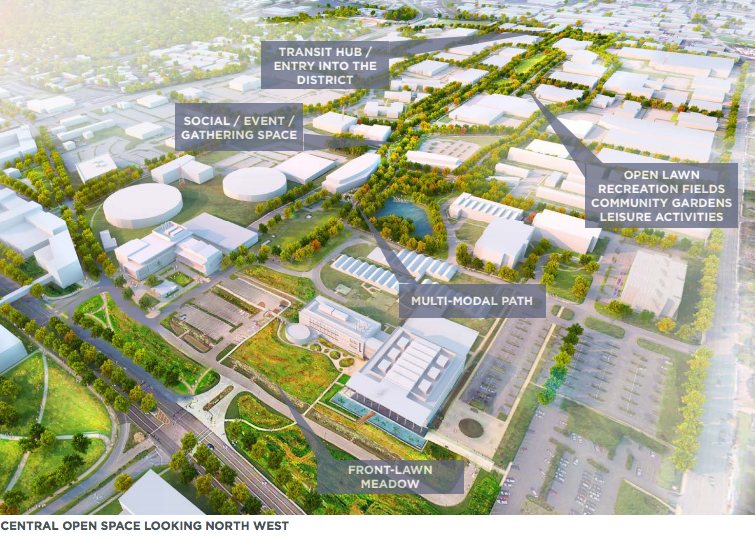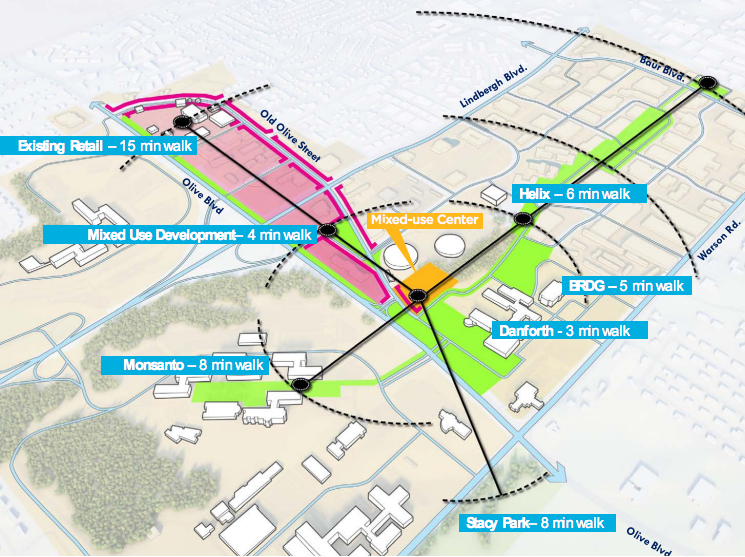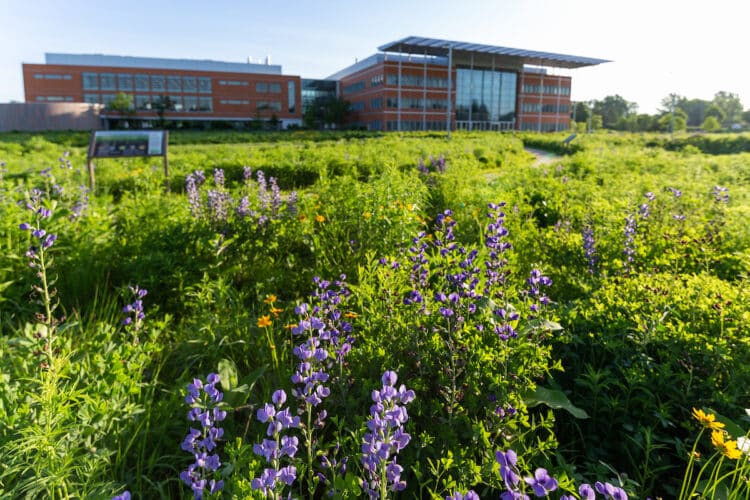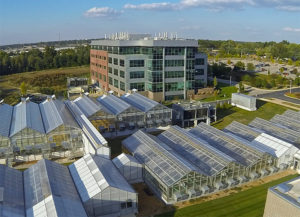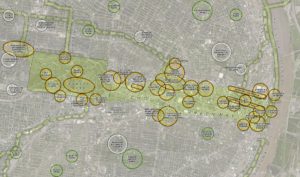
39 North Plant Science Innovation District Plays Home to St. Louis’ Booming AgTech Sector
- 39 North is a 10-year effort to transform a 600-acre area in Creve Coeur into a new agriculture technology innovation district. Here's how the development came to be and an update on the project.
-
“AgTech is St. Louis’s strongest and fastest growing sector.” So says Sheila Sweeney, St. Louis Economic Development CEO and Project Leader of the AgTech innovation district 39 North. Those two entities are partnering with the Daniel Danforth Plant Science Center and BioSTL in cultivating a successful AgTech cluster strategy for the region.
-
The Danforth Center, the world’s largest nonprofit plant-research center, leverages state-of-the-art technologies and a talent network for startups and companies to tap into. BioSTL, which grew from collaboration among Washington University in St. Louis, BJC HealthCare, and the St. Louis Life Sciences Project, is focused on establishing a robust life sciences ecosystem.
-
39 North, a 10-year effort designed to transform a 600-acre area in Creve Coeur into an AgTech innovation district, is already home to Bayer, the Danforth Plant Science Center, the Helix Center BioTech Incubator, and others.
-
Meanwhile, the St. Louis Economic Development Partnership marshals public and private funds to support the growth of the regional cluster.
-
Says Sheila Sweeny, “If you are in AgTech, there is no better place for you than St. Louis.”
-
Explore Creative Clusters and discover the right St. Louis Innovation District for you on EQ's Startup Ecosystem Map.
“Smart, innovative people can’t stay away from each other. We’re going to see collaboration going on between Cortex and 39 North to bring forth the next Monsanto.”
-St. Louis County Executive Steve Stenger, 2017
“The destiny of our Planet, the development of its human and material resources, the spread of scientific knowledge, the population explosion and the evolving world community–these are the subjects […] that ultimately will determine Humanity’s future.”
-James S. McDonnell in 1965 from an article he authored titled “Only The United Nations Can”
In its December 2016 report, “Economic Contributions of Missouri Agriculture and Forestry,” the Missouri Department of Agriculture reported that agriculture, forestry and related industries contributed $88.4 billion and 378,000 jobs to the 2016 state economy. For Sheila Sweeney, CEO of the St. Louis Economic Development Partnership and Project Leader of 39 North, these numbers are mind-boggling.
“AgTech is St. Louis’ strongest and fastest-growing sector,” says Sweeney. “We have an extraordinary pool of talent working in this sector.”
“What we haven’t done is tell that story enough. I don’t want it to be our best-kept secret. I want to tell the world ‘if you are in AgTech there is no better place for you than St. Louis.’”
The Making of a Plant Science Innovation District
39 North is a 10-year effort unveiled in December 2016 by St. Louis County Executive Steve Stenger to transform a 600-acre area in Creve Coeur into a new agriculture technology (AgTech) innovation district.
The area is already home to Monsanto, the Donald Danforth Plant Science Center, the Helix Center BioTech Incubator and BRDG Park, as well as a number of startups and entrepreneur support organizations. The goal is to leverage and build upon the area’s assets by physically connecting the district.

While the establishment of an AgTech innovation district is a new project, Missouri’s agricultural history dates back to the early 18th century, when French settlers began farming in the Ste. Genevieve area. As early as 1859, when Henry Shaw established the Missouri Botanical Garden, the St. Louis region became a leader in plant science.
A statue of Ceres, the Roman goddess of agriculture, was placed atop the Missouri State Capital building dome in Jefferson City when the building was finished in 1917. Throughout the second half of the 19th century, the area along present-day Olive Boulevard (around the future 39 North district) served as a river-to-river Native American high ground pathway with watersheds to the North and South.
As communities developed in the early 20th century, rail lines to Kansas City opened to the North, and in 1930, Lindbergh Boulevard was completed as a bypass of St. Louis. The city of Creve Coeur incorporated in 1949, and post-war construction was residential in nature.
Light industrial enterprises attracted to open land and rail lines set up shop. In the mid-1950s, Monsanto started building east of Lindbergh.
The 1980s witnessed a shift to a service economy, ushering in the construction of more and more office buildings; in the 1990s, the north part of the 39 North district incorporated into the City of Creve Coeur. This industrial area had very little vegetation or pedestrian-friendly routes.
When the Donald Danforth Plant Science Center broke ground in August of 1999, part of its mission was to shorten the time from discovery to practical application. Following the creation of the Center, its founder Bill Danforth also created the Coalition for Plant and Life Sciences (now BioSTL), a non-profit to assist scientists in getting plant and medical innovations to market. As the Cortex Innovation District in Midtown St. Louis was conceived, built and evolved from 2000-2010, its success leading up to and through the economic crisis of 2008-2009 helped establish St. Louis as a center of innovation and entrepreneurship, laying the groundwork for 39 North.
Mapping the Plan
According to Sam Fiorello, Chief Operating Officer and Senior Vice President for Administration and Finance at The Donald Danforth Plant Science Center, the first physical evidence of 39 North can be traced back to the opening of the first BRDG Park (Bio Research and Development Growth) building in 2009. Adjacent to the Donald Danforth Plant Science Center, BRDG Park offers world-class wet labs, office space for lease and on-site workforce training to post-incubator bioscience startups.
In 2012, the St. Louis Economic Development Partnership opened the Helix Center Biotech Incubator, offering similar amenities to BRDG Park but to earlier stage companies. In 2015, the St. Louis Economic Development Partnership won a $500,000 grant from the US Department of Commerce to develop a master plan for 39 North, setting in motion a cohesive effort to build upon the emerging plant science district.

The name 39 North was chosen because the 39th parallel north is the latitude of the physical location of where the district will be in Creve Coeur. The 39th parallel is also the latitude that connects all of the world’s greatest agricultural lands.
The master plan defines the district as bordering Old Olive Street Road to the west, Bauer Boulevard to the north, Warson Road to the east, and the southern property line of Monsanto’s Creve Coeur campus to the south. This area intentionally includes the Danforth Plant Science Center, BRDG Park, Monsanto, and the Helix Center Biotech incubator.
Project work will add new mixed retail, residential and office spaces connected with cultivated green space to appeal to the lifestyles of highly-skilled entrepreneurs and researchers whom the effort hopes to attract to the region.

“The biggest win in year one will be transforming that outdated cloverleaf at Olive and Lindbergh,” says Janet Wilding, Vice President of Major Projects at the St. Louis Economic Development Partnership.
“Once that happens, you’ll really see the district take shape. The 39 North plan is a way to connect the dots. It’s unique to have an innovation district that has amenities such as shops, housing and grocery stores already in place.”
The driving force behind 39 North is to grow job opportunities and spur population growth. 39 North planners envision a build-out of 400 residential units, 550,000 square feet of office space, and 85,000 of retail space.
The first phase will be to build on and connect existing facilities. For example, a $400,000 grant from the Great Rivers Greenway will fund a greenway connection from Monsanto to the Helix Center.
Funding is also being sought for the second phase, which will connect existing mixed-use areas adjacent to 39 North and increase visibility of the district along major transportation corridors. The final phase will be to extend improvements north through the district.
Laying the Groundwork: Transportation & Open Space
A primary goal of the project is to connect existing and new roads within and surrounding the district to create a more cohesive, pedestrian and bike-friendly street grid and free up state-maintained highway ramps for local development. The first phase of the project will be to build on and connect existing facilities.
For example, a $400,000 grant from Great Rivers Greenway will fund a greenway connection from Monsanto to the Helix Center, with the potential to leverage $1.6 million from the federal government. Other transportation and open space project components include:
- Redesigning the intersection at Lindbergh and Olive Boulevards to more efficiently handle all traffic patterns. A “folded diamond” design will replace the existing cloverleaf, easing the general traffic flow and removing Old Olive Street from the state-maintained ramp system
- Redeveloping Old Olive Boulevard into a mixed-use, pedestrian friendly street
- Constructing new internal roads over pre-existing abandoned rail spurs, increasing road connectivity within the district, especially North of Helix Center and Danforth Center.
- Building a pedestrian bridge across Olive
- Creating continuous and connecting pedestrian and bike-friendly spaces throughout the district
- Expanding the existing bike path network to allow riders to bike safely and continuously from Clayton and University City to the district
- Connecting anchor institutions in the southern part of the district (Monsanto, Donald Danforth Plant Science Center, Helix Center, BRDG Park) to the light industrial businesses to the north, promoting collaboration and business development.
Building Development
39 North will consist of a combination of residential, office, and retail space driven by the private sector. The building development component of the project will include:
- A mixed-use center located west of Donald Danforth Plant Science Center, featuring office space, a café and residential spaces. This will be the first building project of the master plan.
- The expansion of BRDG Park north of the Donald Danforth Plant Science Center, which includes two new buildings and a parking garage. This project is already underway.
- The eventual transition of light industrial businesses in the northern part of the district to office and lab use to support plant science.
There are also development sites available on the Monsanto campus fronting Olive Boulevard that could enhance the gateways to and pedestrian traffic in the district.
The district’s planners and developers intend to take a sustainable approach to building and environmental systems design, committing to sustainable building practices, air quality improvements, open space creation, storm water management and bicycle and pedestrian connectivity.

Turning a Vision into a Reality
39 North represents the vision of County Executive Steve Stenger. The vision is that we’ll help to leverage our region’s strengths,” says Stenger. “Strengths like AgTech. With the highest concentration of plant science PhDs in the world, globally recognized research institutions, and major corporates players in agriculture like Monsanto and Bunge, it’s just common sense that we would leverage those assets to further benefit the region. Doing so positions St. Louis to attract the attention of innovators in AgTech and related industries.”

“This makes tremendous economic sense for St. Louis County and for the region as a whole,” says Sweeney. “Our strategic plan is comprehensive, and one goal is to increase our population. We have an aging population. As a result, we must attract and retain young people. To compete for talent, we have to leverage our many assets to a younger demographic that wants to live, work, and play in the same space. When I think about 39N and all it offers–walkability, proximity, beautiful space in which to work–the benefits that the plan bestows on our community are difficult to calculate. 39N enhances our region in so many different ways–in terms of economic development, employment, , innovation, entrepreneurship, and global relevance.”
Along with St. Louis County, the St. Louis Economic Development Partnership is working with a long and growing list of collaborators to make 39 North a reality. In addition to institutional partners such as Monsanto, Danforth Plant Science Center, and American Water, the project depends on the collaboration of a number of state and municipal government entities to solve the problems inherent in such an elaborate undertaking.
The Partnership is also working with a variety of funding resources from the US Commerce Department who funded the creation of the Master Plan, to Great Rivers Greenway which will fund a greenway connection from Monsanto’s Creve Coeur headquarters to the Helix Center.
Fiorello has been a major contributor to the project thus far. The Danforth Center is on the governance committee and worked on the grant from the US Department of Commerce to fund the Master Plan.
“The first physical evidence of 39 North is at BRDG Park,” says Fiorello. “The first of three buildings is just about full with home-grown companies, companies from elsewhere in the US and companies from around the world.”
The space, which was developed by Wexford Science and Technology, is home to almost a dozen plant and life-science and clean-tech companies such as genomics service provider MOGene, St. Louis Community College’s biotech workforce development and training program, and plant breeding leader KWS.
“39 North initiates and articulates connections —live, work, play— in the community,” says Fiorello.
“This is extremely important when attracting talent from all across US and world. It’s even more compelling when you say this is part of this broader initiative–walking paths, green spaces, and connections that will enrich your entire life.”
Venture Café at 39 North, a monthly social and networking event held every Third Tuesday at Danforth Plant Center that launched in early 2017, is designed to encourage dialogue in the district among innovators, scientists, entrepreneurs and the community at large. Patterned after the weekly Venture Café meetups held at the Cortex Innovation Community, the events are open to the public, free of charge, and include complimentary beverages.

Where the Project Stands Now and What’s Next
The entire 39 North master plan project timeline is 10-15 years depending on the availability of federal funding, but there has already been significant progress in the first six months. Since the unveiling of 39 North’s Master Plan late last year, Wilding and the team at The Partnership have been working to secure funding to begin the first major transportation elements of the project.
As it stands, the East-West Gateway has given preliminary approval to fund the transformation of Olive and Lindbergh. The grant would provide $4M of federal transportation funding, matched with $1M of funding from St. Louis County, for a total project cost of $5M. Construction would begin in 2019 and complete in early 2021.
Other big wins include $400,000 in funding from Great Rivers Greenway to begin planning the greenway spine and St. Louis County funding an overhaul of Old Olive Street Rd., turning it into a bike and pedestrian-friendly town center.
Of the project timeline, Stenger says, “We are way ahead of schedule in terms of establishing Venture Café [at 39 North] to generate interest, and earning the funding from the Great Rivers Greenway to start the greenway effort. It’s not what some people think about government: the wheels are not square. They are round and there is a jet on the back of them.”
One of the most critical, and potentially most challenging aspects of 39 North from a governmental perspective is the reconstruction of the intersection at Lindbergh and Olive. Since the governance of the road will shift from state to local, there are hurdles to overcome to make sure that transition goes smoothly.
Those conversations are already underway and going according to plan. Sweeney says, “When the interchange at Lindbergh and Olive is redone, it will create great open space and the ability to utilize that property for some new buildings. It will be significant and monumental. We have businesses interested in looking at those already, which is sooner than we anticipated.
“By planning over 10 years, we have multiple opportunities to fully realize our vision for St. Louis to be the epicenter of AgTech in the United States,” says County Executive Stenger. “This is a big vision that is leveraging one of our region’s biggest traditions – agriculture.”
“We’re focused on ensuring that tradition remains an economic driver of our region well beyond the 21st Century, and the vehicle driving that vision is 39N. This is an incredible opportunity for St. Louis to really own its future.”


